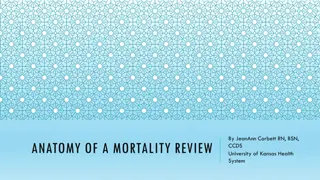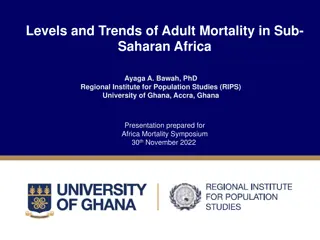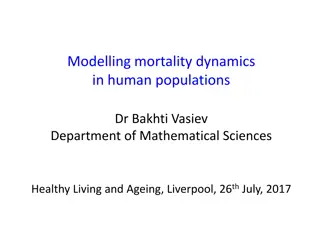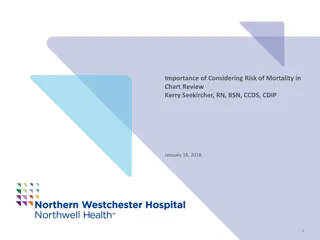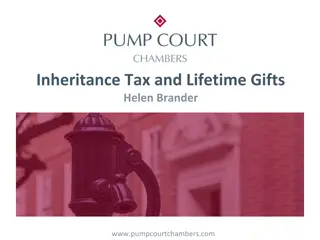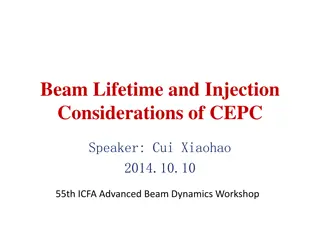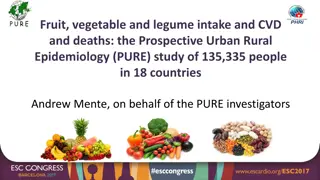Understanding Mortality Laws and Future Lifetime Expectations
Explore the concepts of mortality laws, survival functions, and future lifetime expectations in actuarial science. Learn about exponential and uniform distributions, complete expectation of life calculations, and more through the lens of Salma Alsuwailem's insightful explanations and examples.
Download Presentation

Please find below an Image/Link to download the presentation.
The content on the website is provided AS IS for your information and personal use only. It may not be sold, licensed, or shared on other websites without obtaining consent from the author. Download presentation by click this link. If you encounter any issues during the download, it is possible that the publisher has removed the file from their server.
E N D
Presentation Transcript
Hello! CHAPTER#1 moments Fractional ages Select and Ultimate Mortality Salma Alsuwailem
moments So far, we have covered discrete random variable. In this section, we will discuss the mean and variance of these random variables. , a continuous random variable, and , a
discrete 3
Special Mortality Laws 1-Exponential Distribution (Constant Force) Key Idea the key assumption for this mortality law is that the force of mortality is constant for all ages. This means: x+t= ,for all ages 6
2-Uniform Distribution Key Idea The key assumption for this mortality law is that the future lifetime of ( is uniformly distributed between age. Thus, the future lifetime of between and . This mortality law is also referred to as DeMoivre's law. With this assumption, the expected number of survivors at age given by , where is a constant. Below is a graph of and , where is the limiting is uniformly distributed is against . 7
You are given the survival function S(x)=1 (0.01?)2,0 x 100. Calculate ? 30:50|. The 50-year temporary complete expectation of life of (30) (A) 27 (B) 30 (C) 34 (D) 37 (E) 41 9 Salma Alsuwailem
For T, the future lifetime random variable for (0): (i) > 70 (ii) 40p0 = 0.6 (iii) E(T0) = 62 (iv)E[min(T0,t)]=t 0.005t2 ,0<t<60 Calculate the complete expectation of life at 40. (A) 30 (B) 35 (C) 40 (D) 45 (E) 50 10 Salma Alsuwailem
You are given: Calculate ? 25:25| (A) 14 (B) 14.4 (C) 14.8 (D) 15.2 (E) 15.6 11 Salma Alsuwailem
12 Salma Alsuwailem
For a 4-year college, you are given the following probabilities for dropout from all causes: q0 =0.15 q1 =0.10 q2 =0.05 q3 =0.01. Dropouts are uniformly distributed over each year. Compute the temporary 1.5- year complete expected college lifetime of a student entering the second year, ? 1:1.5| 13 Salma Alsuwailem
Mortality for Audra, age 25, follows De Moivres law with = 100. If she takes up hot air ballooning for the coming year, her assumed mortality will be adjusted so that for the coming year only, she will have a constant force of mortality of 0.1. Calculate the decrease in the 11-year temporary complete life expectancy for Audra if she takes up hot air ballooning. (A) 0.10 (B) 0.35 (C) 0.60 (D) 0.80 (E) 1.00 14 Salma Alsuwailem
Fractional ages! 1- Uniform Distribution of Deaths (UDD) Key Idea The key assumption is that the number of survivors decreases linearly between integer ages. Given lx and lx+1, we can calculate lx+t (where 0 t<1) using linear interpolation: 15 Salma Alsuwailem
2- Constant Force of Mortality Key Idea The key assumption is that the force of mortality is constant between integer ages. Given lx and lx+1, we can calculate lx+t (where 0 t<1) using exponential interpolation: 16 Salma Alsuwailem
You are given the following information on participants entering a special 2-year program for treatment of a disease: (i) Only 10% survive to the end of the second year. (ii) The force of mortality is constant within each year. (iii) The force of mortality for year 2 is three times the force of mortality for year 1. Calculate the probability that a participant who age 3 months dies by the end of month 21. (A) 0.61 (B) 0.66 (C) 0.71 (D) 0.75 (E) 0.82 17 Salma Alsuwailem
Select Mortality! When mortality depends on the age when a person is selected, it is called select mortality. The age at which a person is selected is denoted as [x]. For example: q[50]is the probability that a person currently aged 50, who was selected at age 50, dies within a year. q[49]+1is the probability that a person currently aged 50, who was selected a year ago at age 49, dies within a year. q[41]+9 is the probability that a person currently aged 50, who was selected 9 years ago at age 41, dies within a year. Notice all mortality rates in the example above are mortality rates for a person aged 50. The only difference is the age at which the person is selected. Since the selection process wears off (i.e., we know less about a person if he/she was selected longer ago), we have: q[50] q[49]+1 18 Salma Alsuwailem
Select and Ultimate Mortality! we assume after a certain number of years, selection has no effect on mortality. This period, after which the age at selection has no effect on mortality, is called the select period. The mortality after the select period is called the ultimate mortality. Thus, the complete model consists of a select period followed by the ultimate period. For example, if the select period is 3 years, this means that selection has no effect after 3 years. As a result: The probability that a person currently aged 50, who was selected 3 years ago at age 47, dies within a year is the same as the probability that a randomly selected person aged 50 dies within a year. q[47]+3=q50 The probability that a person currently aged 47, who was selected at age 47, survives 3 years and dies within the following year is: 3|q[47]= since q[47]+3=q50. 3p[47] q50 =p[47] p[47]+1 p[47]+2 q50 19 Salma Alsuwailem
You are given a select-and-ultimate mortality table with a 2-year select period. x q[x] q[x]+1 qx+2 50 0.012 0.024 0.036 51 0.022 0.034 0.046 52 0.033 0.045 0.057 Complete the following table: x l[x] l[x]+1 lx+2 50 100,000 51 52 20 Salma Alsuwailem
THANKS! Any questions? 21 Salma Alsuwailem









